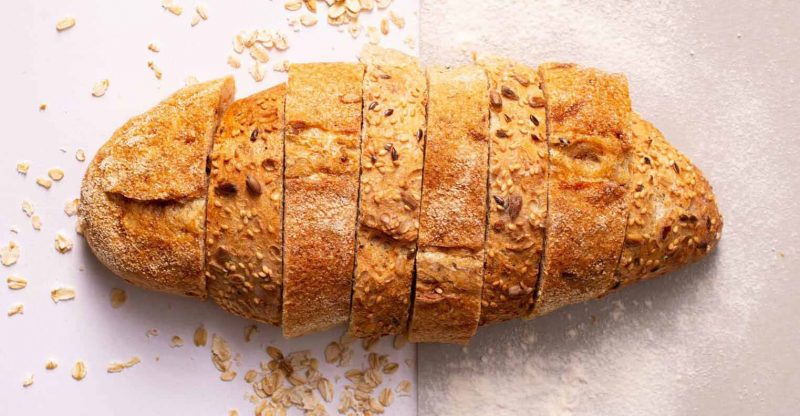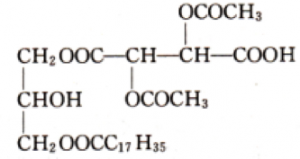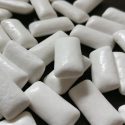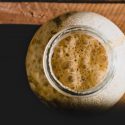What is DATEM (E472e) in Bread? Made of, Uses, Safety, Side effects

What is DATEM | Properties | Uses | Safety | Side effects | 6 FAQs
DATEM, the abbreviation of “Mono- And Diacetyltartaric Acid Esters Of Mono- And Diglycerides Of Fatty Acids”, is the most commonly used emulsifier in bread as a dough conditioner with the European food additive number E472e. Generally, this ingredient is vegan, halal, free of gluten and dairy in food.
What is DATEM?
What is it in bread?
DATEM functions as a dough conditioner, which is used for strengthening the gluten network in dough during the baking process. It improves the texture and increases the volume in bread. It is labeled as “DATEM” or usual name “diacetyl tartaric acid esters of mono- and diglycerides” in its label.
What is it made of?
1. Mixed esters
DATEM consists of mixed esters of glycerol with mono- and diacetyl tartaric acids (obtained from tartaric acid) and plant-sourced fatty acids.
Stearic acid is the common fatty acids derived from vegetable sources, such as palm oil, sunflower oil or others.
The final product, DATEM may contain the following substances:
- free glycerol
- free glycerides
- free fatty acid
- free tartaric acid
- free acetic acid
- tartaric and acetic esters of fatty acids
2. Carrier and anti-caking agent
DATEM is easy to absorb water, especially in summer. So the manufacturers don’t make the particle size too small. Meanwhile, there are always carrier and anti-caking agent in DATEM, such as calcium carbonate, tricalcium phosphate and trisodium phosphate.
What is it made from?
DATEM is a synthetic emulsifier made from the esterification of acetic acid, tartaric acid, glycerol and fatty acids. It can also be produced from diacetyl tartaric anhydride with mono- and diglycerides of fatty acids that are derived from edible sources.
Properties
|
Other Names |
|
|
CAS Number |
308068-42-0 |
|
Chemical formula |
Variable |
|
Molecular Weight |
Variable |
Appearance
Off-white to light yellow waxes with a slightly acidic smell.
Solubility
Soluble in most common fat solvents, methanol, acetone and ethyl acetate, insoluble in acetic acid and water. It can be dispersed in water and does not decompose for a long time. The 3% dispersion in water has a pH of 2 to 3. HLB value 8 to 10.
Structure

Stearic acid as the fatty acid
It is the mixed esters of glycerin in which one or more of the hydroxyl groups of glycerin esterified by diacetyl tartaric acid and fatty acids. There are two hydroxyl groups esterified in the above structure, one is by diacetyl tartaric acid, another one is by fatty acids.
What are the Uses of DATEM?
It is mainly used as a dough conditioner for baked products, especially for yeast-leavened products, white bread and rusks. Also in bread improvers and in ready-mixed flours. Here’s a closer look at its various uses and functions.
Bread
Increase dough fermentation and dough capacity, improve dough stability, improve gas retention, enhance volume and improve the crumb texture of the bread.
Cake
Provide emulsion properties and improve the crumb structure.
Biscuits & Cookies
Improve the texture and reduce hardness in fat-reduced biscuits without the loss of taste.
Sweet dough, Pastry and Donuts
Improve machinability and raw material tolerance.
Coffee Whitener
Provide stabilization properties.
Whipped toppings
Improve the stabilization and whipping properties in toppings.
Cheese
Improve melting properties and texture.
Soups, sauces and dressings
Improve heat and emulsion stability.
Other applications include:
- Ice cream
- Beverage whiteners
- Vegetable Protein Drinks
- Emulsified sauces
- Canned coffee or tea
Is DATEM Safe?
Its safety as a food additive has been approved by the FDA, EFSA and JECFA.
U.S. Food and Drug Administration
Food Safety and Uses
DATEM is generally recognized as safe (GRAS) as a direct human food ingredient and can be used in food with no limitation other than current good manufacturing practice. It is used as an emulsifier, an emulsifier salt and a flavoring agent and adjuvant.
The application includes baked goods and baking mixes, nonalcoholic beverages, confections and frostings, dairy product analogs, and fats and oils. (1)
Animal Feed
FDA also stated that the emulsifying agent DATEM is generally recognized as safe when used in accordance with good manufacturing or feeding practice. (2)
European Food Safety Authority
DATEM (E 472e) is authorised as a food additive in the European Union (EU) in accordance with Annex II and Annex III to Regulation (EC) No 1333/2008 on food additives and categorized as “additives other than colours and sweeteners” (3)
Scientific panel on food additives and flavourings had a meeting in Oct, 2019 for the discussion of Acetic acid, lactic acid, citric acid, tartaric acid, mono- and diacetyltartaric acid, mixed acetic and tartaric acid esters of mono- and diglycerides of fatty acid (E472a-f). (4)
UK Food Standards Agency
Categorized as an emulsifier, stabiliser, thickener and gelling agent. (5)
Food Standards Australia New Zealand
It is an approved ingredient in Australia and New Zealand with the code number 472e. (6)
JECFA (Joint FAO/WHO Expert Committee on Food Additives)
Function class: food additives, emulsifier. (7)
Acceptable daily intake (ADI): ADI “0-50 mg/kg bw” set since 2003. (8)
What are the possible Side Effects of DATEM?
It is common that sometimes consumers have questions if DATEM is bad for our health and what are the side effects.
We understand that consumers prefer natural food and have concerns about the artificial emulsifier in the foods we eat. There are few health risks were reported, including allergic reaction, toxicity and so on.
A published study in 2002 said that DATEM may lead to adrenal overgrowth and heart muscle fibrosis on rats. (9)
Is it safe for pregnant?
Generally, it is safe but better consult with your doctor.
Frequently Asked Questions About DATEM
Is it Natural?
DATEM is not natural as it is made from chemical synthesis. Acetic acid, tartaric acid, glycerol and fatty acids are the main raw materials.
Is It Halal?
Yes, DATEM is halal, complies with the policy “Materials should not be derived from: pork or its derivatives, Khamr (alcoholic beverages) or khamr derivatives which are physically separated from Khamr, blood, carrion, and parts of a human body.” We can find some China manufacturers certificated with MUI halal.
Is It Kosher?
Yes, it is kosher pareve. We can find some suppliers certificated with kosher in OU Kosher.
Is It Gluten free?
Yes, it is gluten free and can be used as an emulsifier in food without gluten. But as it is primarily used in baking to strengthen the gluten network in the dough, so it may make no sense in gluten-free doughs. Do you think so?
Is It Vegan?
Yes, it is vegan, DATEM produced from chemical synthesis, the raw materials and manufacturing process without the use of animal matter or products derived from animals. It is considered vegan and suitable to add in the diet of vegetarians.
Is It Dairy Free?
Yes, it is dairy free as it doesn’t derive from a dairy source. People who’re lactose intolerance or with milk allergy can eat the food with it.
Conclusion
Now you may have a good knowledge of the emulsifier – DATEM (E472e), from its production; composition; uses in bread; approved safety, possible side effects and some FAQs such as is it vegan, gluten free, synthetic or natural.
What kinds of food packaging have you found this ingredient in? Let me know in the comments.



Brand: Betty Crocker banana nut bread
Hi Baker,
Thanks for your information.
Bisquick Baking and Pancake Mix and PopTarts. Contrary to what is stated here, it may not be safe according to other web sites, and is not approved in Europe.
Kelloggs Pop-tarts
Hi Judy,
It is approved in Europe as with the E number 472e.
Found it in Verde Salsa jar made by Taco Bell
Tostitos Avocado Salsa
how to use e472e?what is the dose? can be used in cake?
Rice Krispie Treats, which makes sense.
Whole wheat breads by Pepperidge Farm (not to disclude white bread or other PF products, but i only have sprouted grainwhole wheat, 15 grain whole wheat and whole grain whole wheat in my pantry, and all three contain DATEM. I take solace in knowing I’m not a rat.
Completely knocks me out for hours. It is in Bisquick Heart Smart and in Belvita. I worry about what it does to my body that I cannot stay awake. I don’t hear people talking to me, doors slamming, or the dog barking. I’ve stayed away from mono- and diglycerides for years, but just caught on to DATEM.
Found it in LU Le Petit Beurre biscuits.
Thank you for your work. Found it because of LU biscuits.
I found Datum in Walmarts Italian bread.
Just another inflammatory chemical we can’t metabolize . When are we going to be able to vote on who runs the FDA ?
How do I find out if emulsifiers and other food additives use palm oil or canola oil – concerns about deforestation and
general environmental issues means I avoid these two oils hidden under general classification of ‘vegetable oil’? Kris